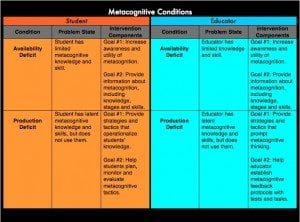Education is an abstract process. Therefore, frameworks are frequently used to help educators and students visualize intangible information. In my experience, successful learners automatically and regularly rely upon a variety of frameworks to help them process new information. In fact, many times our frameworks are what allow us to transform information into usable knowledge. Unfortunately, struggling learners lack frameworks. This deficiency hinders their ability to navigate difficult material. Metacognitive learners intentionally use frameworks to efficiently process information. I’ve included a few metacognitively inspired frameworks that have informed our metacognitive tutoring program.
All students reach outcomes when studying. The question is whether their outcomes will align with those they need. This is a question of learning transfer. There are two types of transfer students engage in while studying: far and near. Far transfer is when the skills and conditions in the current context are very different from those in the future transfer context. Near transfer is when those skills and conditions are similar. Research suggests that near transfer is much more attainable than far transfer. We use the image above to help students align the outcomes they obtain while studying with those needed for their course(s). Our primary task is to help students use the same thinking skills while studying that are needed on their tests and tasks. Unfortunately, students often use different thinking skills while studying than those required to perform well on exams. By helping students exercise the same thinking skills while studying that they will need to demonstrate later, we are convert far transfer experiences into near transfer experiences. And as the research suggests, students’ thinking, learning and performance improves.
Transfer of Knowledge Framework
This is a bottom line framework. Learning is about transfer. I would go so far as to say that there is no learning without transfer. It is the underlying purpose of learning. When kids learn a new basketball move, for example, they implicitly desire to replicate the move in the future. Whether the future is two seconds or two weeks later, the child is measuring his or her success on how well the skill transfers. Another example is when we learn a song. We hope to transfer it to a later moment, perhaps in memory or in action by singing it. Likewise, when students go to class, do homework or any other school-related task, they ultimately will be tested on whether they can transfer their knowledge. When students finish elementary school, they will need to transfer their knowledge to their middle grades. From middle school, students will need to transfer their skills to high school. You get the picture.

Metacognitive Conditions Framework
Understanding students’ metacognitive conditions enables tutors to tailor their interventions to the students’ needs. The image below simply portrays the two conditions in which students and educators fall.
Stages of Study Sequence
Often we perform tasks without clearly understanding how the task unfolds. The Stages of Study sequence shows students the stages in which they routinely engage when studying. This illustration is used to help students break down, and thus slow down the interrelated steps involved in studying. Tutors are able to then address the tasks in isolation.
How People Learn Image
Ever tried drinking from a fire hose? Well, that’s how students feel when it comes to figuring out how they learn. The abundance of information about how students learn has made the idea of determining how students acquire knowledge seem utterly unattainable. Below is a simple, yet effective research-based visual for helping students conceptualize what goes on in their heads when studying. In short, students have unexpressed goals in mind each time they study, they interact in some manner, and throughout the process they reach outcomes. Their outcomes are reflected in their conversations and on their tasks and tests. The next article will feature more frameworks that help abstract processes more visible and manageable.





0 Comments